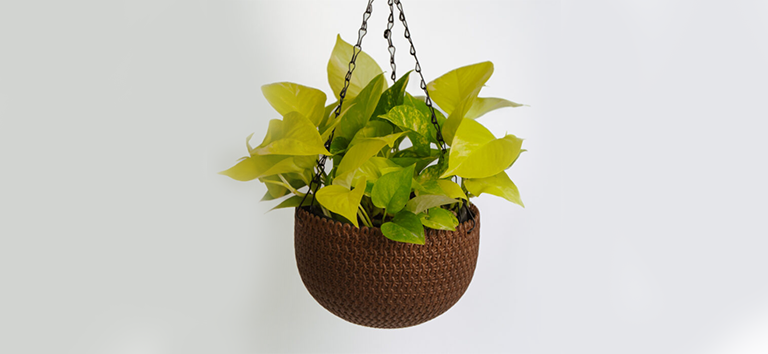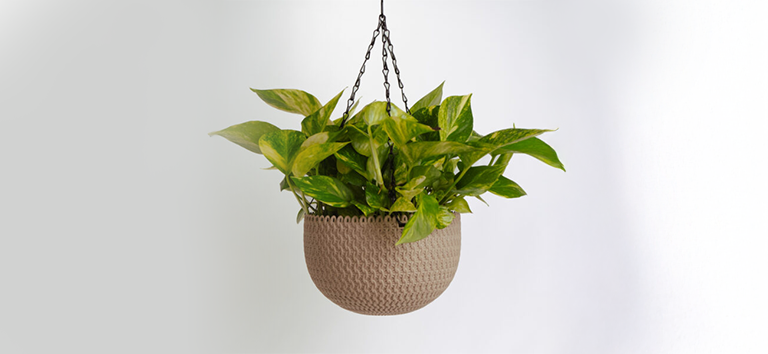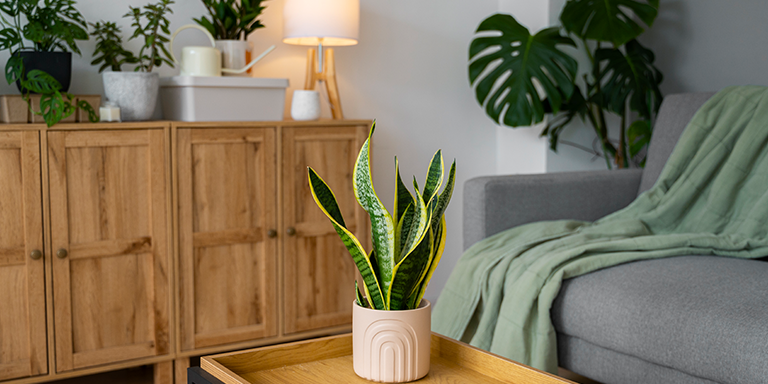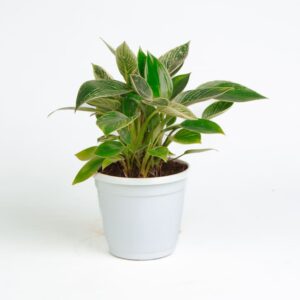Few houseplants have been as broadly popular as the Money Plant. With its reflective, heart-shaped leaves, easy maintenance schedule, and strong symbolic link to good fortune, it’s a darling of homes and workplaces everywhere. But aside from its fame for attracting wealth and good fortune, this green gem also brings freshness and serenity to whatever room it inhabits. Let’s delve into all there is to know about this unassuming yet mighty plant, its meaning, benefits, best direction, and how to care for it properly.
What Is a Money Plant?
Money Plant, also scientifically referred to as Epipremnum aureum or Pothos, is an indoor creeper that thrives well due to its hardy nature. It features trailing vines and green leaves that may be splashed with white or yellow streaks. It’s among the lowest-maintenance plants you can have indoors, which makes it ideal for starters. You can plant it in soil and water, and it grows well under different conditions, be it sunny corners, shaded shelves, or even glass jars on your office desk.
The Money Plant, in most cultures, is a symbol of growth, prosperity, and positive energy. It’s not about aesthetics but about the feelings of balance and serenity it brings into daily life.
What Makes the Money Plant Special?
One thing that makes the Money Plant special is the fact that it’s incredibly versatile. It can develop long, dangling vines that you can simply hang loose, or you can use them to climb up walls and supports. It cleans indoor air by removing toxic pollutants, enhances oxygen, and eliminates stress.
Aside from science, there’s emotion and belief, for people have looked at this plant as a sign of good luck for centuries. Wherever it’s placed, be it home or office, it is said to bring wealth and harmony. It’s no wonder it’s among the most auspicious plants given during housewarmings and new starts.
Top Money Plant Benefits for Your Home and Office
The Money Plant advantages go far beyond just being pleasant to the eyes.
- Air Purification: It eliminates toxins such as formaldehyde and benzene from indoor air, greatly supplying cleaner and healthier air.
- Relieving Stress: Studies reveal that green plants reduce anxiety and weariness, and the environment becomes more peaceful.
- Financial Symbolism: Vastu Shastra and Feng Shui believe that the plant brings prosperity, growth, and good fortune.
- Easy Maintenance: Even if you tend to forget to water it from time to time, it keeps flourishing, ideal for hectic schedules.
- Mood Booster: The greenery of new leaves immediately lightens up any gloomy spot, improving your mood and concentration.
Whatever your living room or office, the Money Plant is a tiny gesture that provides huge benefits.
Best Money Plants for Home to Bring Luck and Prosperity
There are many types of Money Plants, and each one has its own beauty. Here are a few that are considered to attract good luck and prosperity into your life:
Money Plant – Njoy

Small, decorative, and charmingly patterned, the Money Plant Njoy truly lives up to its name. Small, heart-shaped leaves with arresting white and green patterns resemble hand-painting and make it a stylish addition to any corner.
Ideal for bookshelves, side tables, or desks, this variety thrives in indirect, bright light and must be watered when the topsoil is dry. Its compact size makes it ideal for small apartments or home offices, and its beauty is a fine addition with zero fuss. Set it in a hanging basket or a pottery pot, and let it quietly enjoy the attention.
Money Plant – Golden

The Golden Money Plant is probably the most popular and adored of them all. Its radiant golden-green leaves represent optimism, energy, and prosperity, a real Vastu favorite.
This quick-climbing plant does well both in soil and water, so it’s versatile for indoor decorating. You can have it trail down from shelves or climb on a trellis for a dense, tropical effect. The Golden Money Plant also cleans the air, removing toxins and encouraging healthier breathing indoors. It’s not only auspicious, it’s also breezily uplifting for your mood and for your space.
Money Plant – Variegated

For a person who enjoys contrast and texture, the Variegated Money Plant is the perfect choice. Leaves on this plant have a combination of green and creamy white and are delicate but with high visual impact. This variety works best in hanging baskets or wall planters where vines can flow down freely. Low maintenance and quick to grow, the Variegated Money Plant lightens dark spaces with its pale, light-hued leaves. It does well in moderate light and requires little watering, so it’s easy on the hands. Beyond its aesthetic appeal, it’s also said to create balance and harmony in the energy of your space.
Pachira (Money Tree)
Easily linked with Feng Shui, the money tree, or Pachira aquatica, is a representation of wealth, fortune, and stability. Its braided trunk and dark green shiny leaves give it a classy indoor conversation piece appearance. It is commonly placed in offices or entryways by many, as they believe it brings in wealth and expansion.
The Pachira also likes bright, indirect light and light watering once a week. It’s commonly cultivated as a bonsai, symbolizing balance and serenity. Whether you hold to its symbolism or not, there’s no question about its elegant beauty and the feeling of tranquility it brings to a space.
Jade Plant
Richly textured, shiny, and endearingly charming, the Jade Plant is an all-time favorite for homes and offices alike. Nicknamed the “Friendship Plant,” it brings with it promises of prosperity, good fortune, and enduring friendships. With round, coin-sized leaves, it is the perfect match for its reputation for pulling in wealth and positivity.
Jade plants prefer light and need to be watered very little, so they are one of the lowest-maintenance plants to have. Most people put them in front of the entrance or on work tables to welcome prosperity and good fortune. They slowly but pleasantly grow with time, giving a space character and warmth.
Monstera Deliciosa
Though not a conventional “money plant,” the Monstera Deliciosa is now used as a contemporary emblem of wealth and growth. Its huge, split leaves provide an emphasis of dramatic, tropical style that gives space to vacant nooks with a feeling of life and opulence.
The Monstera thrives under bright, indirect light and irregular watering. Its wide leaves symbolize expansion and energy, making it a great choice for individuals who want prosperity and self-improvement. In modern interior design, it’s regarded as a symbol of upward progress.
They all have unique charm and energy, and you can pick one depending on space, light, and the energy you wish to introduce into your home.
How to Care for Your Money Plant the Right Way
Having knowledge on how to take care of Money Plant is the secret to maintaining it healthy and green. The good news is it does not require much.
- Light: Indirect sunlight is ideal. Try to shun direct, harsh rays that are likely to scorch the leaves.
- Water: Water sparingly when the topsoil is dry. Too much water can cause the roots to rot.
- Soil: Employ well-draining soil. A combination of garden soil, sand, and compost is the best.
- Humidity: It prefers a little humidity. Mist leaves from time to time.
- Pruning: Prune long vines to promote new growth and keep it in shape.
- Fertilizer: Feed every 3–4 weeks with a light liquid fertilizer during the growing seasons (spring and summer).
If you care for it regularly, your Money Plant will shower you with healthy vines and shiny green leaves throughout the year.
Money Plant Direction as per Vastu: The Key to Wealth & Positivity
If you’ve ever wondered in which direction a money plant should be kept, Vastu Shastra offers a clear answer: the southeast direction is considered the best for the Money Plant. This direction is ruled by Lord Ganesha and the planet Venus, both connected to wealth and luck.
Keeping the plant here is said to attract prosperity and wealth. Do not position it in the northeast direction, though, as it can cause negativity or clog the passage of good energy.
For offices, placing the plant close to a cash counter or your workplace maximizes focus and productivity. Knowing the right direction of the money plant according to Vastu guarantees that the advantages of the plant go beyond greenery, they reach to abundance and harmony.
Disadvantages of Money Plant
While the Money Plant is not difficult to maintain, it’s well worth noting a few downsides:
- Overwatering Problems: Excessive water destroys the roots rapidly.
- Toxic to Pets: If chewed, the sap of the plant can cause irritation to pets.
- Poor Growth: Insufficient light or fertilization can slow its growth.
- Tangling: If not controlled, its long vines become untidy.
These aren’t a deal-breaker, however. With a little care, you can quickly handle these small problems and continue to keep your plant growing.
FAQ
1. How to grow Money Plant in water?
You can grow a Money Plant in water using a healthy cutting with at least two nodes. Place the cutting in a glass jar or bottle filled with clean water, ensuring the nodes are submerged. Change the water every 7–10 days to keep it fresh and prevent odor or algae growth. Keep it near a bright spot with indirect sunlight.
2. Does Money Plant need sunlight?
Yes, but not excessively. Money Plant loves bright indirect sunlight. Direct sunlight for extended periods of time will scorch its leaves, particularly in summer. It thrives in a place close to the window receiving filtered light. If your plant is indoors and receives inadequate natural light, you can rotate it weekly or bring it closer to a brighter spot to facilitate even growth.
3. How to grow Money Plant?
To cultivate a Money Plant, you can use soil or water. In soil, choose a well-draining medium and water sparingly once the topmost layer is dry. If you’re cultivating it in water, see to it that you provide regular water changes and utilize a clear glass container so that you can observe the roots. It’s one of the most effortless plants to cultivate and does well with little care, which makes it ideal for beginners.
4. Why is it called Money Plant?
Money Plant is thought to attract financial growth and wealth, hence its name. Its round, coin-shaped leaves symbolize good fortune and money. In most cultures, the plant is also said to attract more financial stability and happiness into your home or working environment the healthier your plant is.
5. How to grow Money Plant faster?
To help your Money Plant grow quicker, subject it to indirect light, frequent watering, and a little organic fertilizer every month when it is in its growing stage. Ensure that the pot drains well, since wet roots are slow to grow. Pruning the plant every now and then helps it grow new branches and thus become bushier and greener.
6. How often should I water my Money Plant?
A Money Plant does not enjoy sitting in wet soil, so water sparingly when the top inch of soil is dry. In summer, this could be weekly, and in winter, every 10–12 days. Always provide a pot that has drainage holes. If water-grown, replace the water regularly to keep it fresh and prevent stagnation.
7. What fertilizer is good for a Money Plants?
Use a weak, balanced liquid fertilizer every 3–4 weeks during spring and summer months. Never over-fertilize, excess nutrients can burn the roots. Organic alternatives like compost tea or diluted seaweed solution are also great, they’re non-toxic and make the Money Plant healthy and green.
8. Is Money Plant bad for health?
No, a Money Plant is not unhealthy. Actually, it’s said to clean indoor air by removing toxins and adding oxygen. Though the sap of the plant can irritate if swallowed or if it comes in contact with delicate skin, so it’s advised to keep it away from pets and small children.



 Philodendron birkin
Philodendron birkin